Archive for the 'Directors: Welles' Category
Homage to Mme. Edelhaus
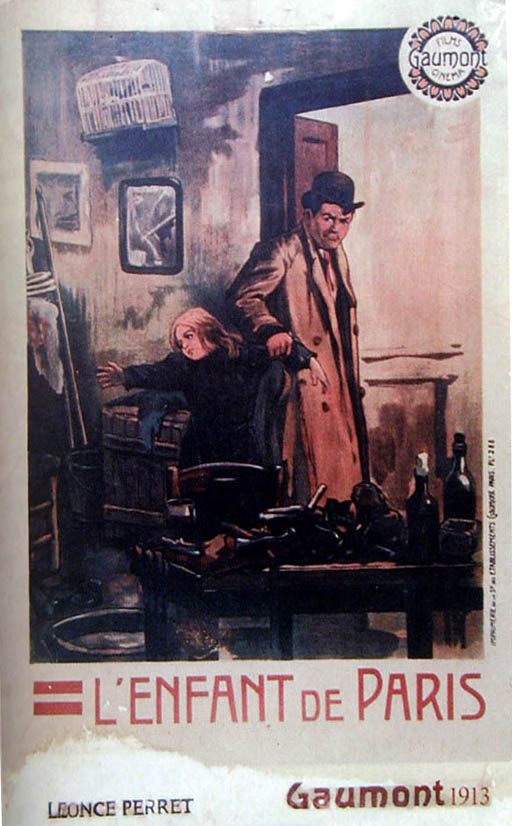
Why are Americans polarized between francophobia and francophilia? Some people mock the French for liking Jerry Lewis, when most French people probably don’t even know who he is. Others think that France is the repository of world culture and represents the finest in writing about the arts, even though the Parisian intelligentsia can be pretentious and hermetic.
But we must face facts. When it comes to cinephilia, the French have no equals. They grant film a respect that it wins nowhere else. Spend a year, or even a month, in Paris, and you will feel like a Renaissance prince. This is a city where one lonely screen can run tattered prints of One from the Heart and Hellzapoppin!, once a week, indefinitely.
My first trip was too brief, only a week in 1970, but my second one—four weeks of dissertation research in 1973—left me exhausted. Reading Pariscope on the way in from the airport, I learned about a Tex Avery festival. I checked into my hotel and Métro’d to the theatre, where I and a bunch of moms and kids gazed in rapture upon King-Size Canary. Another time, also coming in from the airport, Kristin and I passed a marquee for King Hu’s Raining in the Mountain. Next stop, Raining in the Mountain. My memories of The Naked Spur, Ministry of Fear, Liebelei, Tati’s Traffic, and Vertov’s Stride Soviet! are inextricable from the Parisian venues in which I saw them.
Sound like a lament for days gone by? Nope. You can find the same variety on offer today. Of course the two monthlies, Cahiers du cinéma and Positif, have to take a lot of credit for this. Add Traffic, Cinéma, and several other ambitious journals, and you get a film culture unrivalled in the world.
Critics from Louis Delluc onward have led thousands of readers toward appreciating the seventh art. Historians like Georges Sadoul, Jean Mitry, Laurent Mannoni, Francis Lacassin, and others have enlightened us for decades. Academic film analysis would not be what it is without Raymond Bellour, Noel Burch, Marie-Claire Ropars, Jacques Aumont, and a host of other scholars. Above all stands André Bazin, the greatest theorist-critic we have had.
And the books! Arts-and-sciences publishing receives government subsidies; the French understand that books contribute to the public good. There are plenty of worse ways to spend tax dollars (e.g., trumped-up military invasions). The French, like the Italians, have created an ardent translation culture too. If you can’t read something in Russian or German, there’s a good chance it’s available in French.
I was reminded of the glories of Gallic film publishing when the mailman tottered to my door this week with twenty-two pounds worth of recent items I’d ordered. I haven’t even read them yet; otherwise, they’d be filed with Book Reports. Instead I want to spend today’s blog celebrating them as fruits of an ambition that has no counterpart in English-language publishing. All are grand and gorgeous and informative to boot.
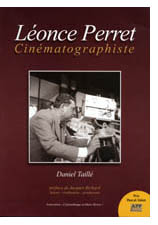 Daniel Taillé, Léonce Perret Cinématographiste. Association Cinémathèque en Deux-Sèvres, 2006. 2.5 lbs.
Daniel Taillé, Léonce Perret Cinématographiste. Association Cinémathèque en Deux-Sèvres, 2006. 2.5 lbs.
A biographical study of a Gaumont director still too little known. Perret was second only to Feuillade at Gaumont, and he performed as a fine comedian as well. His shorts are charming, and his longer works, like L’enfant de Paris (1913), remain remarkable for their complex staging and cutting. After a thriving career in France, Perret came to make films in America, including Twin Pawns (1919), a lively Wilkie Collins adaptation. He returned to France and was directing up to his death in 1935.
Although the text seems a bit cut-and-paste, Taillé has included many lovely posters and letters, along with a detailed filmography, full endnotes, and a vast bibliography. It compares only to that deluxe career survey of the silent films of Raoul Walsh, published by Knopf. . . .Oh, wait, there’s no such book. . . .Think there ever will be?
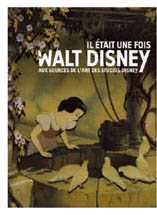 Il était une fois Walt Disney: Aux sources de l’art des studios Disney. Galéries nationales du Grand Palais, 2006. 4 lbs.
Il était une fois Walt Disney: Aux sources de l’art des studios Disney. Galéries nationales du Grand Palais, 2006. 4 lbs.
A luscious catalogue of an exposition tracing visual sources of Disney’s animation. Illustrated with sketches, concept paintings, and character designs from the Disney archives, this volume shows how much the cartoon studio owed to painting traditions from the Middle Ages onward. It includes articles on the training schools that shaped the studio’s look, on European sources of Disney’s style and iconography, on architecture, on relations with Dalí, and on appropriations by Pop Artists. There’s also a filmography and a valuable biographical dictionary of studio animators.
Some of the affinities seem far-fetched, but after Neil Gabler’s unadventurous biography, a little stretching is welcome. This exhibition (headed to Montreal next month) answers my hopes for serious treatment of the pictorial ambitions of the world’s most powerful cartoon factory. The catalogue is about to appear in English–from a German publisher.
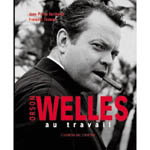 Jean-Pierre Berthomé and François Thomas. Orson Welles au travail. Cahiers du cinéma, 2006. 4 lbs.
Jean-Pierre Berthomé and François Thomas. Orson Welles au travail. Cahiers du cinéma, 2006. 4 lbs.
The authors of a lengthy study of Citizen Kane now take us through the production process of each of Welles’ works. They have stuffed their book with script excerpts, storyboards, charts, timelines, and uncommon production stills.
The text, on my cursory sampling, will seem largely familiar to Welles aficionados; the frames from the actual films betray their DVD origins; and I would like to have seen more depth on certain stylistic matters. (The authors’ account of the pre-Kane Hollywood style, for instance, is oversimplified.) Yet the sheer luxury of the presentation overwhelms my reservations. A colossal filmmaker, in several senses, deserves a colossal book like this.
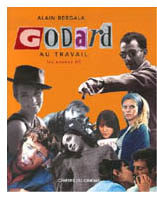 Alain Bergala. Godard au travail: Les années 60. Cahiers du cinéma. 2006. 5 lbs.
Alain Bergala. Godard au travail: Les années 60. Cahiers du cinéma. 2006. 5 lbs.
In the same series as the Welles volume, even more imposing. If you want to know the shooting schedule for Alphaville or check the retake report for La Chinoise (these are eminently reasonable desires), here is the place to look. Detailed background on the production of every 1960s Godard movie, with many discussions of the creative choices at each stage. Once more, stunningly mounted, with lots of color to show off posters and production stills.
Anybody who thinks that Godard just made it up as he went along will be surprised to find a great degree of detailed planning. (After all, the guy is Swiss.) Yet the scripts leave plenty of room to wiggle. “The first shot of this sequence,” begins one scene of the Contempt screenplay, “is also the last shot of the previous sequence.” Soon we learn that “This sequence will last around 20-30 minutes. It’s difficult to recount what happens exactly and chronologically.”
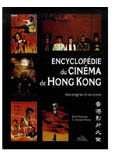 Emrik Gouneau and Léonard Amara. Encyclopédie du cinéma du Hong Kong. Les Belles Lettres, 2006. 6.5 lbs.
Emrik Gouneau and Léonard Amara. Encyclopédie du cinéma du Hong Kong. Les Belles Lettres, 2006. 6.5 lbs.
The avoirdupois champ of my batch. The French were early admirers of modern Hong Kong cinema, but their reference works lagged behind those of Italy, Germany, and the US. (Most notable of the last is John Charles’ Hong Kong Filmography, 1977-1997.) More recently the French have weighed in, literally. 2005 gave us Christophe Genet’s Encyclopédie du cinéma d’arts martiaux, a substantial (2 lbs.) list of films and personalities, with plots, credits, and French release dates.
Newer and niftier, the Gouneau/ Amara volume covers much more than martial arts, and so it strikes my tabletop like a Shaolin monk’s fist. There are lovely posters in color and plenty of photos of actors that help you identify recurring bit players. Yet this is more than a pretty coffee-table book. It offers genre analysis, history, critical commentary, biographical entries, surveys of music, comments on television production, and much more. It has abbreviated lists of terms and top box-office titles, as well as a surprisingly detailed chronology.
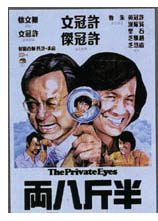 Above all—and worth the 62-euro price tag in itself—the volume provides a chronological list of all domestically made films released in the colony from 1913 to 2006! Running to over 200 big-format pages, the list enters films by their English titles and it indicates language (Mandarin, Cantonese, or other), release date, director, genre, and major stars. Until the Hong Kong Film Archive completes its vast filmography of local productions, this will remain indispensable for all researchers.
Above all—and worth the 62-euro price tag in itself—the volume provides a chronological list of all domestically made films released in the colony from 1913 to 2006! Running to over 200 big-format pages, the list enters films by their English titles and it indicates language (Mandarin, Cantonese, or other), release date, director, genre, and major stars. Until the Hong Kong Film Archive completes its vast filmography of local productions, this will remain indispensable for all researchers.
Mme. Edelhaus was my high school French teacher. A stout lady always in a black dress, she looked like the dowager at the piano during the danse macabre of Rules of the Game. She was mysterious. She occasionally let slip what it was like to live under Nazi occupation, telling us how German soldiers seeded parks and playgrounds with explosives before they left Paris. When I asked her what avant-garde meant, she replied that it was the artistic force that led into unknown regions and invited others to follow–pause–“in the unlikely event that they will choose to do so.”
For three years Mme. Edelhaus suffered my execrable pronunciation. When I tried to make light of my bungling, she would ask, “Dah-veed, why must you always play the fool?”
I suppose I’m still at it. But thanks largely to her I’m able to read these books as well as look at them. She opened a path that’s still providing me vistas onto the splendors of cinema.
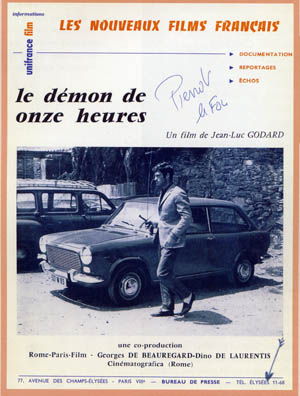
Walk the talk
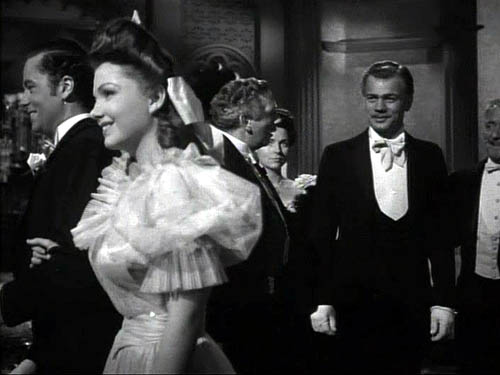
The Magnificent Ambersons.
“It’s only history,” Jack Valenti is reported to have said when allowing scholars access to MPAA files. (1) After studying Hollywood for over thirty years, I should be used to the ways in which trade journalists (and some critics) forget or ignore historical precedents in moviemaking. But I still get bug-eyed when I encounter something like the Variety piece on TV director Tommy Schlamme (Studio 60 on the Sunset Strip).
The subhead tells us that this DGA nominee is known for his “hallway shots.” That gets my interest.
I lose interest fast. The writer tells us that Schlamme
developed the “walk and talk” on Sports Night and then mastered it on The West Wing.
The shot—which features two or more actors moving from one location to another on the set, often from one office to another via a hallway—has become a Schlamme signature.
The first sentence could be read as saying that Schlamme invented the walk-and-talk. Since I spent a little time studying this technique in The Way Hollywood Tells It, my inner film historian cries out, Aarrgh. Long before Sports Night (aired 1998-2000) and The West Wing (1999-2006), movies were developing such bravura shots.
The oblique view
In the prototypical walk-and-talk, two or more characters advance, and the camera tracks along, keeping them centered as they move through the environment. Such shots are quite uncommon in the silent cinema, but they emerge in 1930s films from many countries.
They were truly “signature shots” for Max Ophuls and the lesser-known Erik Charell. In Charell’s captivating The Congress Dances (1931) Lillian Harvey sings while a carriage takes her through an entire town and into the country, all in flowing tracking shots. Call it a ride-and-sing.
If that’s not as pure an instance as you’d like, we can find nice ones during a street scene of The Thin Man (1934). A more somber example occurs in Mizoguchi Kenji’s Story of the Last Chrysanthemums (1939), with the camera in a river bed angled upward at the couple it follows.
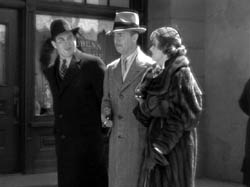
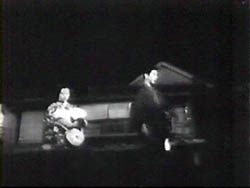
Usually such traveling shots from the 1930s and 1940s are shot obliquely to the actors. That is, the performers are seen in a ¾ view, and they walk along a diagonal path with respect to the frame edges; the camera moves on a similar trajectory. Sound cameras were mounted on dollies that usually ran on tracks. Framing the actors head-on raised problems with this gear. Performers couldn’t walk smoothly if they were stepping within rails, and there was a risk that the rails in the distance might appear in the frame. It was simpler to set the camera at an oblique angle so that actors could walk unimpeded and the tracks wouldn’t be seen. Directors continued to use this framing into the 1950s, as in Welles’ Othello (1952) and Fuller’s Forty Guns (1957). Both are unusually long takes; in the second, poor Gene Barry seems to be panting to keep up with the other men.
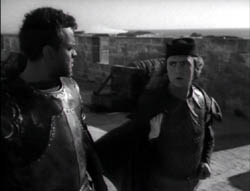
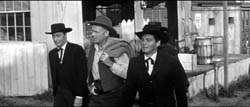
Back off
Today’s walk-and-talk is more likely to be a head-on framing, with the camera retreating from the actors. (More rarely, it dogs them from behind.) With a retreating Steadicam, you don’t have to worry about glimpsing the ground or floor behind the actors, in the distance, since there are no track rails to be exposed. Again, though, we have some precedents, most famously the splendid camera movements, evidently executed with a crane, in the ball sequences of The Magnificent Ambersons (1942), when George and Lucy stroll through the party.
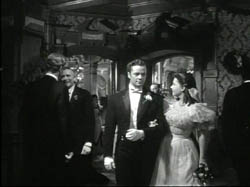
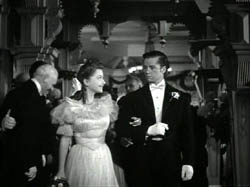
When location shooting became more common in the 1940s and 1950s, cameras could be supported on more versatile dollies that didn’t require track rails, and these reverse-tracking shots become a bit more common. Kubrick, highly influenced by Welles and Ophuls, captured his officers striding through the trenches of Paths of Glory (1957). Vincent LoBrutto’s information-packed book (2) tells us that Kubrick’s dolly rolled backward on the planks that the actors walked on (authentic details, as boards were indeed used in the muddy trenches). Godard’s long traveling through the office lobby in Breathless (1960) was shot from a wheelchair.
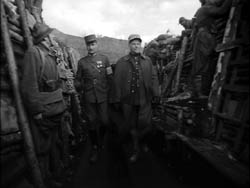
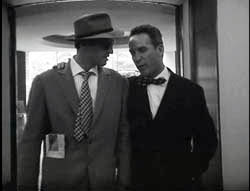
Such head-on (and tails-on) shots can be found in several films well into the 1970s, as in Arthur Hiller’s The Hospital (1970). In fact, hospitals, police stations, and other sprawling institutional spaces seem to invite this approach.
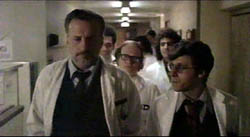
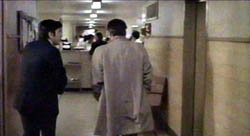
By the 1980s, these shots proliferate in American films largely because the Steadicam makes them easy. One famous example is De Palma’s Bonfire of the Vanities (1990), which follows the drunken Peter Fallow through a hotel as he picks up and drops off many other characters.
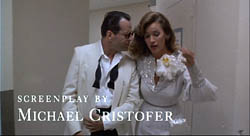
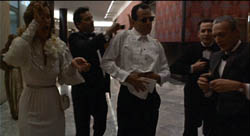
Today such shots are very common in both high- and low-budget films. Schlamme’s “signature” device seems to be in pretty wide circulation. At best it’s a convention, at worst a cliché.
They’re called actors; let them perform action
I argue in The Way Hollywood Tells It that walk-and-talk is one of two principal staging techniques of contemporary Hollywood. The other, usually called stand-and-deliver, plants the characters facing one another and simply cuts from one to the other. The scene is built primarily out of singles (shots of only one actor) or over-the-shoulder framings. Here’s a typically static dialogue scene from The Matrix Revolutions (2003).
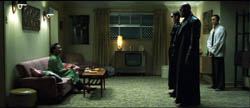
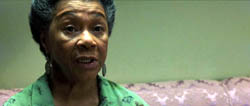
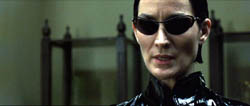
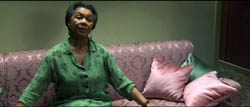
Both stand-and-deliver and walk-and-talk began in the studio era, decades ago, but then there were other options as well. Directors cultivated smooth, unobtrusive blocking tactics that moved characters in ways that reflected the developing scene. The actors had to perform with their whole bodies, and bits of business motivated them to circulate through the setting and turn toward or away from the camera. One example given earlier on this blog is from Mildred Pierce; here’s another, from the program picture Homicide (1949).
Detective Michael Landers has a hunch that the purported suicide of a former sailor is really murder. He has to persuade Captain Mooney to let him pursue some leads out of his jurisdiction. Today this might be played out in a stand-and-deliver session, with both men seated and shot/ reverse-shot cutting carrying the scene. But the director Felix Jacoves decides to let his actors earn their money through ensemble staging, not merely line readings. Here are just three shots from the middle of the scene that illustrate my point.
Landers stands at Mooney’s desk and gets a refusal. As he turns away to the left, Mooney walks to the rear files to put the papers away.
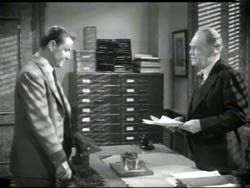
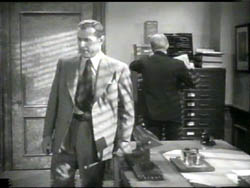
As they’re retreating to the opposite ends of the screen, Landers’ partner Boylan, who’s been offscreen for this phase of the scene, strides into the center and pauses at the door. The result of this choreography is both a balanced three-point composition and a chance to let us observe Boylan’s skeptical reaction to Landers’ next plea.
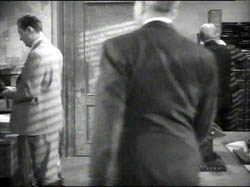
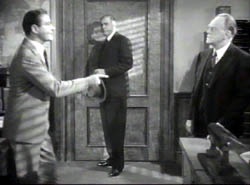
The camera tracks in as Landers approaches Mooney. Boylan shifts closer as well. What seems somewhat stagy as we analyze it doesn’t look obtrusive on the screen, because we’re following Landers’ arguments and watching the older men’s reactions. The closer framing and the position of the men, now face to face rather than separated by a desk, raises the dramatic pressure. As Landers pauses, Mooney folds his arms—a simple piece of body language that lets us know he’s still resisting.
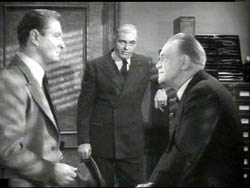
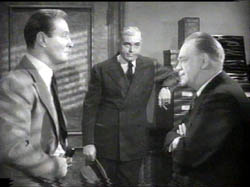
Now a cut to Mooney, in an OTS framing, stresses his continued resistance as he tells Landers off, and a reverse shot gives Landers’ angry reaction.
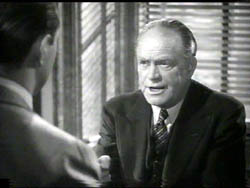
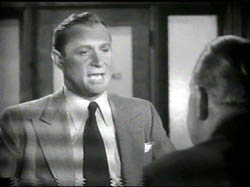
Interrupting the sustained take, the shot/ reverse shot cuts have gained more emphasis than if they were part of a string of OTS shots. Jacoves has saved his cuts and closer views for a moment that raises the stakes visually as well as dramatically.
I’m not claiming that this is a brilliant stretch of cinema. (But you have to like a plot in which the hero defeats the killer by denying him access to insulin.) It’s just that the sequence activates, in a way that directors once took for granted, aspects of film art that we don’t find too often nowadays. Once you didn’t have to choose between Steadicam logistics and static dialogue; there is a very wide middle ground if you’re willing to move actors around the set and give them some body language and prop work. No need for a walk-and-talk here.
Schema and revision
The Variety article explains that Schlamme utilizes his long walk-and-talks to save time and money. But directors in the studio era shot their fully elaborated scenes like that in Homicide to be economical as well. If actors know their lines and hit their marks, playing out pages of dialogue in a few sustained setups can be very efficient; the Homicide full shot consumes 45 seconds. I’d argue that most contemporary directors have never learned to stage scenes this way. It’s a lost skill set. I make the case in more detail in Figures Traced in Light and The Way Hollywood Tells It.
To some extent, however, another skill set has emerged. Some walk-and-talks in The West Wing and other programs have an extra feature that the Variety writer and I haven’t mentioned. Often character A and B are walking toward us down the corridor, then B drifts off and C catches up with A. A and C walk for a while, then A peels off and C picks up somebody else, and so on. This approach is suited to multiple-protagonist dramas. You can show the plotlines crossing and separating.
I’m no TV historian, but I think that this technique showed up on St. Elsewhere (1982-1988), and it’s definitely on display in ER (1994-). Hospitals again. I think we also find this mingling/ separating choreography in contemporary film, but I can’t recall many examples in earlier eras. You could argue that one of the shots in the Ambersons’ ballroom does this, though I don’t think it’s a pure instance. (The principle of overlapping character actions is at work in many Renoir films, most famously in the final party melee in Rules of the Game, but Renoir doesn’t employ what we’re calling a walk-and-talk.) Did movies pick up this intertwined walk-and-talk from TV or vice-versa? I don’t know. If you do, drop me a line!
In On the History of Film Style and Figures Traced in Light, I argue that stylistic change in filmmaking often follows a logic of what art historian E. H. Gombrich calls schema and revision. (3) A pattern or practice becomes standardized, but then creators extend it to new situations or find new possibilities in it, and they modify it.
Camera movements have long been used to link characters. For instance, when Nick Charles circulates drinks in The Thin Man, Van Dyke tracks leftward to follow him from guest to guest.
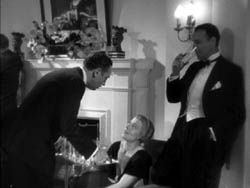
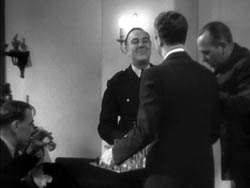
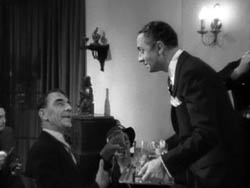
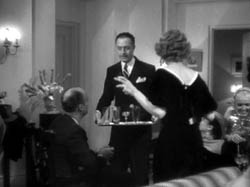
So maybe in the 1980s and 1990s, when ensemble stories had to balance attention among several major characters, directors blended the multiple-interaction aspect of lateral camera movements with the schema of the advancing walk-and-talk. The result makes characters move in and out of each others’ orbits along a single trajectory. Whoever came up with this device, I’d speculate that it arose from the realization that the backing-up walk-and-talk could be repurposed for dramas following the fates of several protagonists.
It’s only history, but it matters if we want to understand stylistic continuity and change.
(1) Thanks to Richard Maltby for passing this along.
(2) Vincent LoBrutto, Stanley Kubrick: A Biography (New York: Fine, 1997), 141-142.
(3) E. H. Gombrich, Art and Illusion: A Study in the Psychology of Pictorial Representation (Princeton, N. J. Princeton University Press, 1960), especially Chapter III.













